Aim of the strategy
The vision for the economic development strategy manifests itself as a prototype addressing an area below Bengaluru’s outer ring road flyover.
The strategy would aim to mitigate the misuse and relieve the lack of use of abandoned spaces below vertical transport infrastructure in Bengaluru, India. It is an effort at rebranding and reimagining public spaces at the heart of the city thus making them more equitable and vibrant. The urban intervention is consistent with Karnataka’s 2009 Urban Development Policy (UDP) and aims to further the goals set to make Bengaluru a globally competitive city. (Urban Development Dept., 2009)
Thriving urban interventions have the potential to add value to derelict spaces while simultaneously managing deterioration and bringing local communities together. Social neighbourhood development is an advantage born out of implementing such urban interventions thus allowing the local population to appropriate these spaces.
Urban interventions are ‘pocket revolutions’, that produce straightforward solutions to problems concerning the built environment. (Tribble, 2016) Built environment interventions have the potential to imbue citizens with a sense of ownership and belonging.
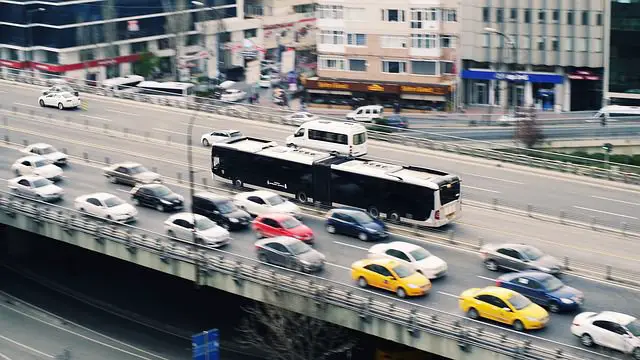
Intervening to rehabilitate the spaces under flyovers in Bengaluru would be an attempt to trigger an urban movement and raise wakefulness regarding the potential of mixed-used urban interventions. This placemaking acts as a catalyst for spaces to be welcoming of people of all ages, abilities, income levels and backgrounds. (PPS, 2015)
Bengaluru, Karnataka, India
Bengaluru is the capital city of the state of Karnataka in Southern India. It is one of the fastest-growing cities[1] in India and is dubbed the ‘Silicon Valley’ of India. (Bharath, et al., 2018) Bengaluru’s population estimated during the 2011 census stood at close to 10 million people. (Directorate of Census Operations, Karnataka, 2011) According to projected growth rates, it is estimated that the current population is closer to 12.5 million in 2020. (population.city, 2020)
Urbanization during 1973–2016 has had a marked influence on the natural resources of the city, such as a decline in green spaces (88%), higher air pollutants and a sharp decline in the groundwater table. (Ramachandra & Aithal, 2016)
The neglected spaces below flyovers and other elevated transport links lack distinctive space and balance. The Doddanekundi flyover on Bengaluru’s outer ring road (ORR) presents one such space.
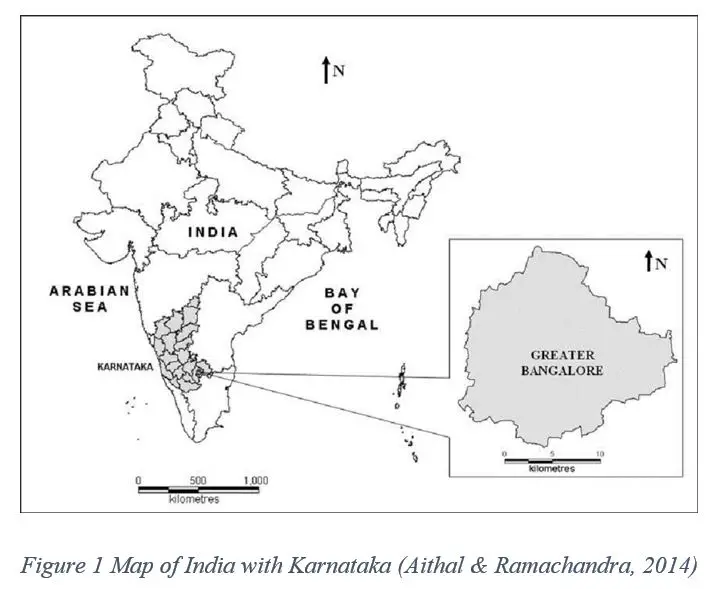
Outer Ring Road- Doddanekundi Flyover, Whitefield, Bengaluru
The Doddanekundi flyover in Bengaluru is a new piece of the puzzle that fits into the city’s outer ring road. The flyover is strategically located to connect people to Whitefield and Sarjapur. These prime areas in the Silicon Valley of India contain tech parks that include The International Tech Park Limited, Bagmane Tech Park, Prestige Tech Park, Ecospace Business Park, and the Export Promotional Industrial Park. Whitefield has transformed from a village-based ecosystem to a highly polluted urban pocket within four decades, covering 81.61% built-up area. (Ramachandra, et al., 2020) According to a study in 2013, this section of the outer ring road leading to Whitefield saw an average of 3500 Passenger Car Units during peak hour traffic. (Directorate of Urban Land Transport , 2013)
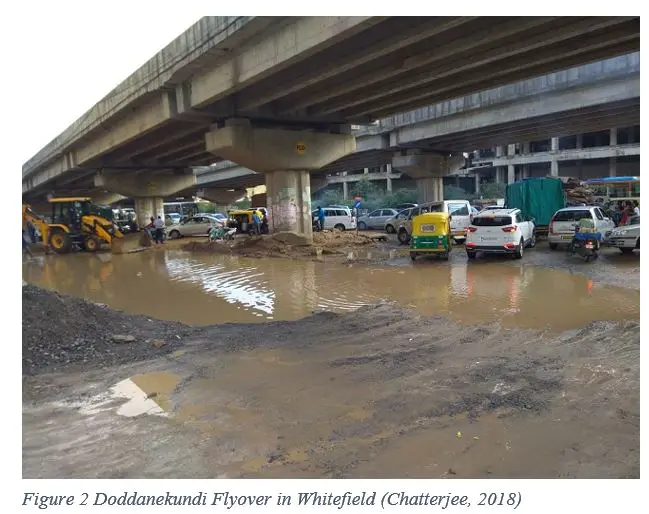
The Housing and Urban Development Corporation (HUDCO) at the National level and the Karnataka Urban Infrastructure Development and Finance Corporation (KUIDFC) at the state level focus on modernizing Bengaluru by urban renewal and urban design. (Benjamin, 2000) The KUIDFC secures funds and serves as the planning agency for most of the mega-infrastructure investments in Bengaluru. (Benjamin, 2000) Large-scale transportation projects such as the Doddanekundi flyover, are often considered transformational tools deployed by governments in metropolitan cities—not just to address mobility issues – but also as approaches to enabling economic development and urban renewal benefits. (Sadoway & Gopakumar, 2013)
Strategy Defence
Residual spaces can no longer be an afterthought. Spaces under elevated sites encompass one of the most vexing influences on a city’s neighbourhood yet constitute one of the last development frontiers. (Design Trust for Public Space, 2013) The wasted space below the Bengaluru ORR flyover stretch has immense value and potential. Often these spaces are overlooked and are considered collateral damage due to a lack of sustainable planning. The urban design of the built environment in Bengaluru has often been criticised with being myopic and haphazard. (Upadhya, 2017) (Sundaresan, 2017) (Banerjee-Guha, 2016)
The space below the flyover has a significant vertical dimension that has resulted in the horizontality being neglected. The undefined leftover space is often occupied by illegal and temporary hawkers. The displaced and vulnerable population of the city often find refuge below these flyovers before being evacuated by the local police. (ET Bureau, 2019)
Providing a role to these wasted spaces would not only augment the aesthetics of the space but reduce further decline. The leftover spaces underneath the flyover have an irregular form as they follow the overhead structure and a massive number of these elevated transport infrastructures have adjacent spaces that are divided and remain inaccessible to each other. ( Mydin & Mohd Kassim, 2019)
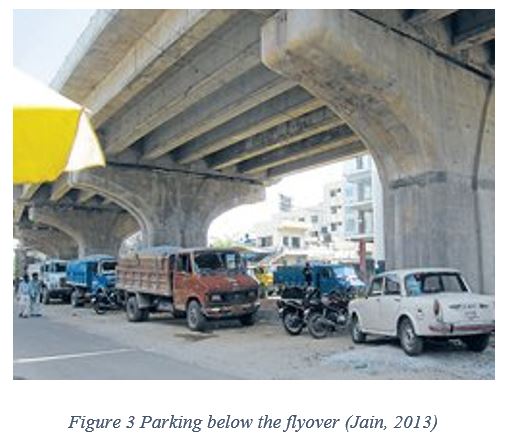
As the figure above illustrates, the space below the flyovers in Bengaluru are regularly used as a parking space for large vehicles resulting in traffic congestion. Streets encompass more than 70% of public space in the city and are very much part of the people constituting their surroundings. (M, et al., 2014)
Waterlogging is a common problem in Bengaluru during the monsoons. The inundated roads disrupt traffic, damage infrastructure and result in the stormwater mixing with solid waste and contaminants leading to water-borne diseases. (Hu, et al., 2018)
There have been non-profit and private organizations who have come forward to organize cleaning drives and beautification projects for the spaces below these flyovers. However, it has become evident in the past few years that these enhancement undertakings only go so far. Without a purpose or a permanent role assigned to these dilapidated spaces, they are going to remain eyesores.
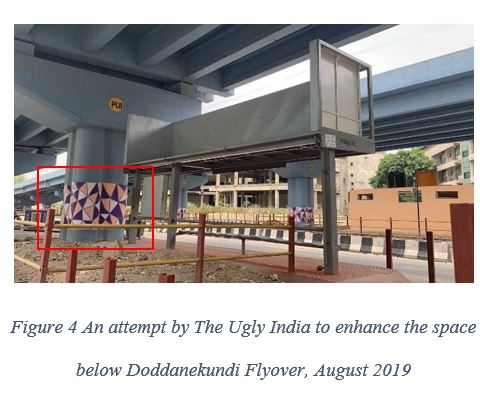
Elements of the Strategy
With the declassification of use, the revitalised space would be expanded to the public throughout the day (Future Spaces Foundation, 2019) providing it with a dynamic character.
Listed below are three adaptations of the urban intervention that can be accommodated at different points below the entire stretch of the Outer Ring Road in Whitefield.
1. Pop-up markets
A public market would act as a productive space to achieve social interaction and help small businesses grow. (El Gawad, et al., 2019) The geostrategic positioning of markets below flyovers makes them accessible while simultaneously being complemented by the prominence of the flyover itself. The role of retail as an extension of the public realm itself can be explored through this element under the Doddanekundi flyover in Whitefield. This variant of the urban intervention could appeal to public-private partnerships. The grey spaces owned by the Bangalore Development Authority (BDA) can be used for any purpose deviating from their previously allotted land use. According to Section 14 of the Karnataka Town and Country Planning Act, infrastructure projects undertaken by PPPs or private developers are authorized for change of land use provided it is in the public’s best interest. (Urban Development Dept., 2012)
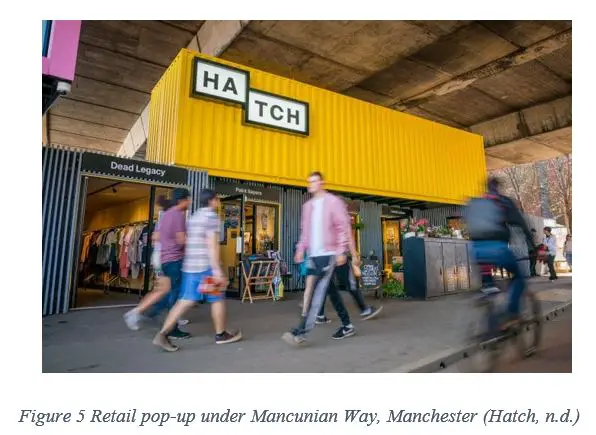
2. Parklets
Encroachment of spaces below these flyovers is a common spectacle. By providing a ‘third area’ such as a parklet, it would discourage unlawful activities happening in forsaken spaces. The success of “Lighter, Cheaper, Quicker” projects is proof that some of the most effective ways to bring communities to public spaces do not have to be expensive or labour-intensive. (PPS, 2012)
Space for civic amenities, parks and open spaces are relinquished to the BDA by the infrastructure developers free of encumbrance. (Krishnamurthy & Ravindra, 2014) Any civic amenity sites owned by the BDA can be used for any purpose irrespective of the land use classification in the Master Plan 2015 – if it is the public’s best interest. (Urban Development Dept., 2012)
3. Creative Incubators
Arts and cultural incubators create a nurturing environment for small and emerging local artists by offering subsidized paces and services. (Kahn, 1995) They aim to stimulate the creation of new jobs and lower existing risks for new creative businesses. (UNESCO, 2016) Bengaluru’s booming start-up culture sets the scene to empower creators to produce and collaborate. Multi-use destinations such as open plazas could help to build civic pride and foster social connections in the community. (El Gawad, et al., 2019) Bottom-up approaches can be coordinated with guidance from Public Art Advisory Committees (Bangalore International Centre, 2019) to set up creative incubators, art installations or events in public spaces. Private commissioning agencies could play a role in the maintenance and conservation of these projects.
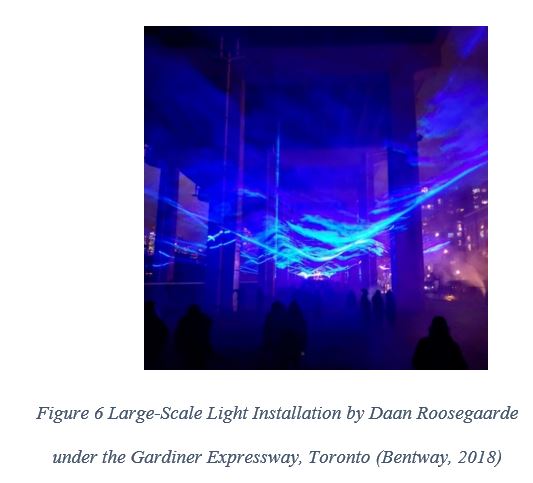
Stakeholders
The communities living closest to the area of intervention would be the primary benefactors of the project, thus making them important stakeholders. The direct involvement of the public is key to the success of this project. Public participation would help to foster a sense of ‘place attachment, place identity and place dependence.’ (El Gawad, et al., 2019)
The Urban Development Policy for Karnataka calls for devolved, participatory governance. (Urban Development Dept., 2009) Community-Based Organizations and Non-Governmental Organizations are channels that advocate for the citizens’ voice to be heard. This is crucial while playing a participatory role in planning in Bengaluru. (B, et al., 2010) Janaagraha is one such organization in Bengaluru working with citizens to catalyse active citizenship in the city’s neighbourhoods and with governments to institute reforms to city governance and planning policies. (Janaagraha, 2013)
Other stakeholders include state and development agencies that establish the physical infrastructure. The Bruhat Bengaluru Mahanagara Palike (BBMP)[2], Bengaluru Metropolitan Land Transport Authority (BMLTA)[3], and Karnataka Slum Clearance Board (KSCB)[4] play major roles in the implementation of any urban intervention in the city. Any private organizations acting as benefactors also hold a stake in the urban intervention.
Strategy Implementation
The built environment is a cross-disciplinary industry spanning public policy, engineering, architecture, urban design, economics and more. Local authorities should actively seek to include “third places”[5] into urban neighbourhoods to ensure that communities have access to safe, vibrant public places. (Future Spaces Foundation, 2019)
Karnataka is one of the highest recipients of development aid from both international organizations as well as central government institutional structures in India. Thus, the burden of what is or will be constructed by these funds falls directly on local planning bodies. (Benjamin, 2000)
Political networks at various levels influence the governance – from policymaking to the implementation and enforcement of the policy. (Sundaresan, 2014) The urban vision detailed in Karnataka’s UDP addresses creating cities that are environmentally sustainable and culturally vibrant. (Urban Development Dept., 2009)
The 74th Constitution Amendment enacted in the 1980s was aimed at improving urban governance by empowering urban local bodies by delegating certain functions like urban planning to local bodies. It also aimed at giving voice to the citizens through the District Planning Committees and Metropolitan Planning Committees. (B, et al., 2010)
Corporate intrusion in the public realm would aid in implementing these spaces below flyovers. Private landowners behind Privately Owned Public Spaces (POPS) have the authority to constrain or encourage the use of outdoor spaces. (Future Spaces Foundation, 2019) Collaborative cross-sector models – including public/private alliances – offer more people access to the public built environment. (Future Spaces Foundation, 2019) Under the Athithidevobhava of the Karnataka government, public and private stakeholders assumed corporate social responsibility and adopted the maintenance of certain public spaces in the city. (Director of Tourism, 2014)
Statutory management agents would play a vital role in the administration and running of these spaces by interceding between the private or government “landlord” and the space occupier. Their sole purpose would be to ensure that the quality of the space is maintained and that the requirements of the space occupier are met concerning retail kiosks. (Reid, 2019)
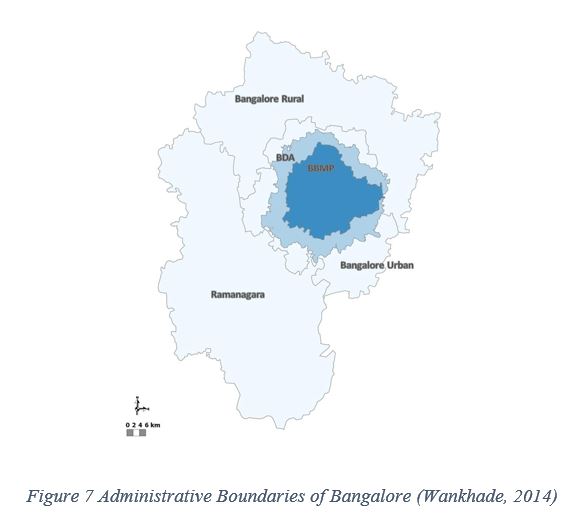
It is important to note that the planning and deployment of the urban intervention should not be absorbed wholly by urban planning administrations but should be acknowledged as a neighbourhood development strategy with the same level of importance and relevance as an urban development concept commissioned by the municipality. (Tribble, 2016)
Strategy Evaluation
- Access and linkages: Connecting the modified space under the flyover with its physical surroundings would encourage people to walk to the space and utilize it. A successful public place is one that is easy to get to and get through. (PPS, 2018) Improved pedestrian flow in the modified space below the Doddanekundi flyover would attract people to visit and immerse themselves in the intervention.
- Safety: Pedestrian and bicycle safety as a concept in urban planning is yet to come to the forefront in Bengaluru. The intervention would aim to focus on pedestrian safety along primary transport corridors with the addition of medians to reduce the crossing distance for pedestrians. (WHO, n.d.). By having an activity zone below the flyover, the space is transformed into a Woonerf thus creating living streets to either side of the space. A Woonerf fashions a public space for social and commercial activities, while incorporating a dedicated area for play. (WHO, n.d.) Shaped by Jan Gehl’s Quality Criteria, it is understood that for a public space to feel safe, it requires protection from traffic and accidents, against crime and violence and against unpleasant sensory experience. (UN Habitat, 2015) (Gehl, 2010)
- Activity Level: By ensuring that activities are continually taking place in the space below the flyover, there exists a constant influx of participants. Activities are the reason why people visit the place initially and why they continue to return. (PPS, 2018) The current happenings of the previously underutilised space would distinguish it from other public places in Bengaluru. Providing passive and active pursuits that draw from the strength and unique identity of each typological location (Sah, 2013)is key to the success of an urban intervention such as this. The footfall through the space can be calculated using tools such as ‘People Moving Count’ by Gehl People. (Gehl, n.d.) It helps to set a quantitative target for pedestrian traffic in the space.
- Comfort and image: If the space below the Doddanekundi flyover is utilised efficiently, it would result in the obsolescence of the space for objectionable activities. It would also cease to exist as a dumping ground for the communities around. The comfort conveyed by the space includes cleanliness and the availability of places to sit- the importance of which is generally underestimated.(PPS, 2018) Tools such as the ‘Twelve Quality Criteria’ By Gehl People can be employed to research how the public intervention is experienced by the users. (Gehl, n.d.)
Scope and Limitations
It is important to note that the intervention is located along the median of a busy ring road. The noise and air pollution in the area owing to the vehicles could deter people from visiting the area.
Additionally, some grey areas below flyovers are used by vulnerable groups to shelter themselves at night. There exists a moral dilemma in converting these spaces into kiosks, parklets or art exhibits. These interventions could be deemed hostile and result in making the space unliveable for socially excluded groups.
Furthermore, the absence of a well-developed urban land market in Karnataka and the increasing demand for serviced land has resulted in rising land prices. (Urban Development Dept., 2009) Poor land management in Bengaluru is a consequence of wanting government management. Associated costs of development and the effort could deter the conversion of these urban grey parcels of land into sustainable, agreeable urban interventions.
However, shared public spaces are social resources that draw communities together and provide important opportunities for societal engagement. (Future Spaces Foundation, 2019) The project would ideally have a widespread impact by employing behavioral nudges customized to the individual elements of the strategy being deployed. A lot can be done with a little – minimal infrastructure investments can result in a transformation of previously static spaces.
Author Bio: Esha Biddanda Pavan is a graduate student at Cardiff University currently pursuing a degree in International Planning and Urban Design. She holds a bachelor’s degree in architecture from VTU, Bangalore. Her research interests lie in urban regeneration and placemaking in cities.
[1] The population density in the region has increased from 7881 persons/km2 (2001) to 11 664 persons/km2 (2011). (Directorate of Census Operations, Karnataka, 2011)
[2] BBMP is the administrative body responsible for civic amenities and infrastructural assets of the Greater Bengaluru metropolitan area. It consists of 7 municipal councils, 1 town municipal council and 111 surrounding villages. (BBMP, 2018)
[3] BMLTA coordinates land transport activities in the Greater Bengaluru metropolitan area. It coordinates transportation and infrastructure projects as well as taking decisions regarding the integration of land use planning and urban transport. (Directorate of Urban Land Transport, 2008)
[4] KSCB is responsible for matters of environmental improvement clearance and redevelopment of the slums. (KSDB, 2007)
[5] Urban sociologist Ray Oldenburg defines the third place as a place of refuge other than the home or workplace where people can regularly visit and commune with friends, neighbours, co-workers, and even strangers. (Mehta & Bosson, 2010)
Bibliography
- Mydin, D. M. A. O. & Mohd Kassim, S. N. A., 2019. Revitalizing the dead spaces underneath flyover: Potentials and Issues. Eftimie Murgu, 26(1), pp. 153-160.
- Aithal, B. H. & Ramachandra, T., 2014. Wetlands: Kidneys of Bangalore’s Landscape. National Wetlands newsletter, December, pp. 11-16.
- Artefact Group, n.d. Smart cities cycle: Building bike culture with behavioral economics. [Online]
Available at: https://www.artefactgroup.com/ideas/smart-cities-cycle/
[Accessed 02 April 2020]. - Banerjee-Guha, S., 2016. Contemporary Urban Policy in India: A Critique of Neoliberal Urbanism. In: Spatial Diversity and Dynamics in Resources and Urban Development. s.l.:Springer, pp. 67-79.
- Bangalore International Centre, 2019. Spaces to Places: Art in Public Spaces. [Online]
Available at: https://bangaloreinternationalcentre.org/event/spaces-to-places-art-in-public-spaces/
[Accessed 25 April 2020]. - BBMP, 2018. About Us. [Online]
Available at: https://bbmp.gov.inen/about-us
[Accessed 01 April 2020]. - Benjamin, S., 2000. Governance, Economic Settings, and Poverty in Bangalore. Environment & Urbanization , 12(1).
- Bentway, 2018. Waterlicht. [Online]
Available at: https://www.thebentway.ca/event/waterlicht/
[Accessed 28 April 2020]. - Bharath, H. et al., 2018. Green to gray: Silicon Valley of India. Journal of Environmental Management, Volume 206, pp. 1287-1295.
- B, M., K, H. & Krishne, G., 2010. Urban Governance and Master Plan of Bangalore City. Institute of Town Planners, India, 7(2), pp. 01-18.
- BMRCL, 2017. Namma Metro About Us. [Online]
Available at: https://english.bmrc.co.in/AboutUs
[Accessed 24 March 2020]. - BMRCL, 2018. Twitter. [Online]
Available at: https://twitter.com/cpronammametro?ref_src=twsrc%5Egoogle%7Ctwcamp%5Eserp%7Ctwgr%5Eauthor
[Accessed 23 March 2020]. - Chatterjee, S., 2018. 2 weeks since Sept 15 deadline by K’taka Deputy CM, Doddanekundi roads remain a mess. The News Minute, 27 September.
- CityMetric, 2015. Here are all the city parks attempting to copy New York’s High Line. [Online]
Available at: https://citymonitor.ai/skylines/here-are-all-city-parks-attempting-copy-new-yorks-high-line-695
[Accessed 25 April 2020]. - Design Trust for Public Space, 2013. Under The Elevated. [Online]
Available at: http://designtrust.org/projects/under-elevated/
[Accessed 20 March 2020]. - Director of Tourism, 2014. Approval to initiate programme for adoption of tourist destinations in collaboration with corporates. Bangalore, Government of Karnataka.
- Directorate of Census Operations, Karnataka, 2011. Census of India 2011, Bangalore: Government of India.
- Directorate of Urban Land Transport , 2013. Traffic Management Study: Whitefield. Findings and Analysis Report, Bangalore: Urban Development Department.
- Directorate of Urban Land Transport, 2008. Overview of BMLTA. [Online]
Available at: http://urbantransport.kar.gov.in/bmlta.html
[Accessed 01 April 2020]. - El Gawad, N. S. A., Al-Hagla, K. S. & Nassar, D. M., 2019. Place making as an approach to revitalize Neglected Urban Open Spaces (NUOS): A case study on Rod El Farag Flyover in Shoubra, Cairo. Alexandria Engineering Journal, 58(3), pp. 967-976.
- ET Bureau, 2019. Homeless people left out in the cold on Bengaluru streets. Economic Times, 11 January.
- Future Spaces Foundation, 2019. Kinship in the City: Urban Loneliness and the Built Environment, London: Future Spaces Foundation.
- Gehl, J., 2010. Cities for People. London: Island Press.
- Gehl, n.d. Public Life Tools. [Online]
Available at: https://gehlpeople.com/tools/people-moving-count/
[Accessed 24 March 2020]. - Gehl, n.d. Twelve Quality Criteria. [Online]
Available at: https://gehlpeople.com/tools/twelve-quality-criteria/
[Accessed 03 April 2020]. - Hatch, n.d. Hatch. [Online]
Available at: https://hatchmcr.com/
[Accessed 25 April 2020]. - Hu, S. et al., 2018. Impacts of Rain and Waterlogging on Traffic Speed and Volume on Urban Roads. s.l., IEEE International Conference on Intelligent Transportation Systems (ITSC).
- India Today, 2015. This is how art can bring boring public spaces to life. [Online]
Available at: https://www.indiatoday.in/lifestyle/story/srishti-institute-of-art-design-and-technology-bangalore-art-in-transit-metro-station-279178-2015-12-28
[Accessed 24 March 2020]. - Indian, T. U., 2019. The Ugly Indian Facebook Page. [Online]
Available at: https://www.facebook.com/login/?next=https%3A%2F%2Fwww.facebook.com%2Ftheugl.yindian%2Fphotos%2Fa.2297496306976278%2F2297633980295844%2F%3Ftype%3D3%26theater
[Accessed 24 March 2020]. - Jain, N., 2013. Illegal parking thrives beneath flyovers. Deccan Herald, 17 March.
- Janaagraha, 2013. About Janaagraha. [Online]
Available at: http://www.janaagraha.org/about-us/
[Accessed 01 April 2020]. - Kahn, M. E., 1995. An Introduction to Arts Incubators. Americans for the Arts Monograph, 28 February, p. 16.
- Krishnamurthy, K. & Ravindra, S., 2014. Professional Practice. 1 ed. New Delhi: PHI Learning.
- KSDB, 2007. KARNATAKA SLUM DEVELOPMENT BOARD. [Online]
Available at: http://housing.kar.nic.in/DOH_KSCB_page.htm
[Accessed 01 April 2020]. - Kumar, C., 2018. Homeless and Hopeless…. The Times of India, 28 October.
- M, B., Srikanth, S. & KS, A., 2014. Urban streets and nodes : A case of Bangalore. International Journal of Scientific & Engineering Research, 5(7).
- Mehta, V. & Bosson, J., 2010. Third Places and the Social Life of Streets. Environment and Behaviour, 42(6), pp. 779-805.
- Meristem Design, n.d. A4 Hammersmith Flyover. [Online]
Available at: https://www.meristemdesign.co.uk/hammersmith-flyover
[Accessed 25 April 2020]. - NDTV, 2011. Namma Metro wipes out business for retailers. NDTV, 14 December.
- population.city, 2020. Bangalore Population. [Online]
Available at: http://population.city/india/bangalore/
[Accessed 20 March 2020]. - PPS, 2012. THE LIGHTER, QUICKER, CHEAPER TRANSFORMATION OF PUBLIC SPACES. [Online]
Available at: https://www.pps.org/article/lighter-quicker-cheaper
[Accessed 25 April 2020]. - PPS, 2015. EQUITABLE PLACEMAKING: NOT THE END, BUT THE MEANS. [Online]
Available at: https://www.pps.org/article/equity-placemaking-gentrification
[Accessed 25 April 2020]. - PPS, 2018. What Makes a Successful Place?. [Online]
Available at: https://www.pps.org/article/grplacefeat
[Accessed 27 March 2020]. - Ramachandra, T. & Aithal, B. H., 2016. Bengaluru’s reality: towards unlivable status with unplanned urban trajectory. Current Science, 25 June, pp. 2207-2208.
- Ramachandra, T. V., Sellers, J., Bharath, H. A. & Setturu, B., 2020. Micro level analyses of environmentally disastrous urbanization in Bangalore. Environmental Monitoring and Assessment, Volume 191.
- Rammohan, S. C. R. S. a. E. A., 2011. Namma Metro wipes out business for retailers [Interview] 2011.
- Reid, A., 2019. Public Space as a Social Resource, London: Future Spaces Foundation.
- Sadoway, D. & Gopakumar, . G., 2013. Disassembling infrastructure space: Tracing the links between infrastructure, urban space and governance. Berlin, s.n.
- Sah, S., 2013. Town Square: Bangalore. [Online]
Available at: http://www.gensleron.com/cities/2013/7/17/town-square-bangalore.html
[Accessed 02 April 2020]. - Sundaresan, J., 2014. Who plans and who lives? Urban planning lessons from Bangalore.. [Online]
Available at: https://blogs.lse.ac.uk/southasia/2014/06/11/who-plans-and-who-lives-urban-planning-lessons-from-bangalore-part-two/
[Accessed 02 April 2020]. - Sundaresan, J., 2017. Urban Planning in Vernacular Governance: Land use Planning and Violations in Bangalore : Progress in Planning Journal. Progress in Planning.
- Travel York, n.d. Park & Pedal. [Online]
Available at: https://www.itravelyork.info/park-and-ride/cycling-with-park-and-ride
[Accessed 02 April 2020]. - Tribble, R., 2016. From Urban Interventions to Urban Practice: An Alternative Way of Urban Neighborhood Development. Urban Art: Creating the Urban with Art, July, pp. 155-164.
- UN Habitat, 2015. Global Public Space Toolkit: From Global Principles to Local Policies and Practice, s.l.: UN Habitat.
- UNESCO, 2016. Establishment and Development of Art Incubators. [Online]
Available at: https://en.unesco.org/creativity/policy-monitoring-platform/establishment-development-art
[Accessed 02 April 2020]. - Upadhya, C., 2017. Afterword: Middle Class Activism and Bangalore’s Environmental Predicament. [Online]
Available at: https://journals.openedition.org/poldev/2488#quotation
[Accessed 25 April 2020]. - Urban Development Dept., 2009. Urban Development Policy for Karnataka, Bangalore: Urban Development Department.
- Urban Development Dept., 2012. Guidelines for Change of Land Use, Bangalore: Urban Development Department.
- Wankhade, K., 2014. Future Proofing Indian Cities: Bangalore Diagnostic Report, Bangalore: IIHS.
- WHO, n.d. Pedestrian Safety: A Road Safety Manual for Decision-Makers and Practitioners, Italy: World Health Organization.